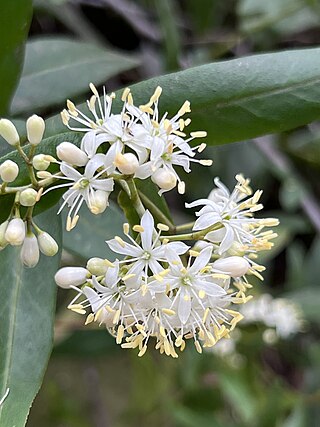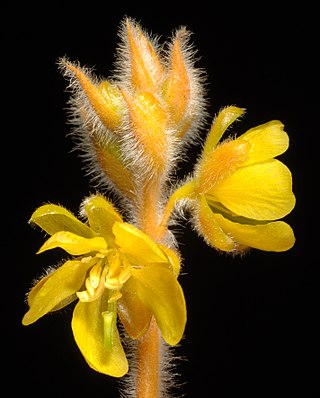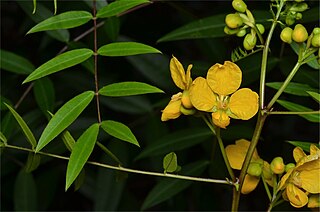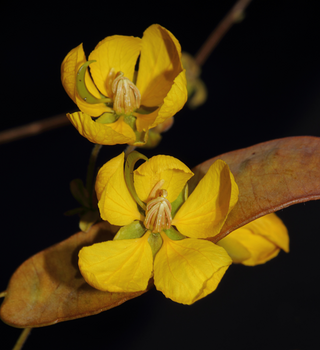
Hymenosporum is a monotypic genus of trees in the family Pittosporaceae. The sole included species is Hymenosporum flavum, commonly known as native frangipani, found in the rainforests and wet sclerophyll forests of New Guinea, Queensland and New South Wales. Despite its common name, it is not closely related to the frangipani, but is related to the widespread genus Pittosporum.

Senna artemisioides, commonly known as silver cassia, is a species of flowering plant in the family Fabaceae and is endemic to Australia, where it is found in all mainland states and territories. It is a small, woody shrub with silver-green leaves and yellow flowers.

Leionema ambiens is a rare shrub growing in the Guyra district of New South Wales and Queensland, Australia. It has long stem clasping leaves and heads of white flowers in spring and early summer.

Phaleria clerodendron, commonly known as scented daphne, scented phaleria or rosy apple, is an evergreen tree or tall shrub in the family Thymelaeaceae. It is endemic to the rainforests of north-eastern Queensland, Australia.

Grevillea angustiloba, commonly known as dissected holly-leaf grevillea, is a species of flowering plant in the family Proteaceae, endemic to southern continental Australia. It is a prostrate, low-lying or erect shrub with deeply divided pinnate leaves and usually red, sometimes orange or pale yellow flowers.

Senna septemtrionalis, commonly known as arsenic bush, is a species of flowering plant in the family Fabaceae and is native to Central America, the southern United States and Mexico, but is naturalised in many other countries. It is an erect shrub with pinnate leaves, with four or five pairs of egg-shaped leaflets, and yellow flowers arranged in groups of five to eight, usually with seven fertile stamens and four staminodes in each flower.

Cupaniopsis wadsworthii, sometimes commonly named duckfoot, or dwarf tuckeroo, is a species of flowering plant in the soapberry family and is endemic to Queensland. It is a slender shrub or small tree with paripinnate leaves with two to eight broadly wedge-shaped or broadly lobed leaflets, and separate male and female flowers arranged in raceme-like thyrses, the fruit a capsule with a seed with an orange aril.
Persoonia brachystylis is a species of flowering plant in the family Proteaceae and is endemic to a restricted area on the west coast of Western Australia. It is an erect, spreading shrub with smooth bark, narrow spatula-shaped to lance-shaped leaves and yellow flowers in groups of ten to twenty.

Flindersia bourjotiana, commonly known as Queensland silver ash, northern silver ash, or white ash, is a species of tree that is endemic to Queensland. It has pinnate leaves arranged in opposite pairs and with between four and eight narrow egg-shaped to elliptic leaflets, greenish white flowers arranged in panicles, and fruit studded with short, rough points.

Mackinlaya macrosciadea, commonly known as mackinlaya or blue umbrella, is a plant in the carrot, fennel and parsley family Apiaceae, found in the Northern Territory and Queensland, Australia.

Senna notabilis, commonly known as cockroach bush, is a species of flowering plant in the legume family Fabaceae, and is endemic to northern Australia. It is an erect, softly-hairy, annual or perennial shrub with pinnate leaves with six to twelve pairs of lance-shaped leaflets, and yellow flowers arranged in groups of twenty to thirty, with seven fertile stamens in each flower.

Senna cardiosperma is a species of flowering plant in the family Fabaceae and is endemic to the western half of Australia. It is an erect shrub or small tree with pinnate leaves, the number and shape of the leaflets depending on subspecies, yellow flowers with ten fertile stamens in each flower, and flat pods.

Senna clavigera, commonly known as pepper leaf senna, is a species of flowering plant in the family Fabaceae and is endemic to eastern Australia. It is a perennial herb with pinnate leaves with four to seven pairs of lance-shaped to elliptic leaflets, and groups of four to twenty yellow flowers in upper leaf axils.

Senna ferraria is a species of flowering plant in the family Fabaceae and is endemic to north-western Western Australia. It is an erect shrub with pinnate leaves with three to four pairs of broadly elliptic to egg-shaped leaflets, and yellow flowers arranged in groups of about twelve, with ten fertile stamens in each flower.

Senna glutinosa is a species of flowering plant in the family Fabaceae and is endemic to central and northern arid areas of Australia. It is a shrub or small tree with pinnate leaves with up to seven pairs of leaflets, their shape depending on subspecies, and yellow flowers arranged in groups with ten fertile stamens in each flower.
Senna heptanthera is a species of flowering plant in the family Fabaceae and is endemic to Arnhem Land in the north of the Northern Territory. It is a creeping, herbaceous perennial with pinnate leaves with one or two pairs of broadly egg-shaped leaflets, and yellow flowers arranged in groups of eight to ten, with seven fertile stamens in each flower.

Senna magnifolia is a species of flowering plant in the family Fabaceae and is endemic to northern Australia. It is an erect, spreading or straggling, mostly glabrous shrub with pinnate leaves with four to six pairs of broadly oblong to round leaflets, and yellow flowers arranged in groups of twenty to sixty, with seven fertile stamens in each flower.

Senna oligoclada is a species of flowering plant in the family Fabaceae and is endemic to northern Australia. It is an erect shrub with pinnate leaves with one to three pairs of elliptic to egg-shaped leaflets, and yellow flowers arranged in groups of three to five with ten fertile stamens in each flower.

Senna pilocarina is a species of flowering plant in the family Fabaceae and is endemic to inland Western Australia. It is a prostrate or upright, spreading shrub with pinnate leaves with five to nine pairs of oblong to wedge-shaped leaflets, and yellow flowers arranged in groups of four or five, with ten fertile stamens in each flower.

Senna pleurocarpa, commonly known as fire bush or chocolate bush, is a species of flowering plant in the family Fabaceae and is endemic to Australia. It is a spreading shrub with pinnate leaves with five to seven pairs of broadly elliptic to egg-shaped leaflets, and groups of five to twelve yellow flowers arranged in dense groups of twenty to sixty on the ends of branches and in upper leaf axils.



















